Porous border with DR Congo turns Rwanda into a wildlife trafficking hub
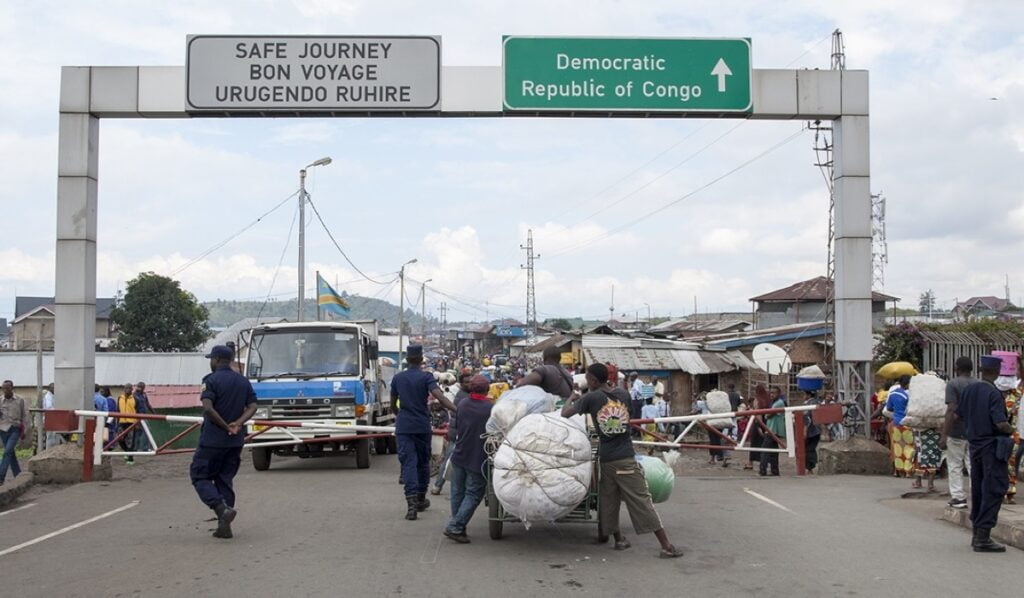
"Petite Barriere" border crossing between Rwanda and Democratic Republic of Congo is the third Border post in Africa that clears many passengers per day .35,000 -38,000 people cross this border everyday
A well-guarded border with just two major entry posts divides the Rwandan city of Rubavu, located in northwestern Rwanda, from its twin of Goma, the capital city of the North Kivu Province in the eastern region of the Democratic Republic of the Congo (DRC).
Due to the tensions that broke out between Rwanda and DR Congo in 2022 and continue to exist to date, movements are still closely observed at the established border checkpoints as people load goods of all kinds onto carts to be transported to the other side of the border a little further away after routine security and migration control.

A few miles away, some members of the local community are reluctant to refrain from using porous entry points to cross into the neighboring DR Congo
Rugaju, a moto-taxi driver who requests to go by his first name due to the sensitive nature of the subject, currently operates from Bugeshi, a rural Rwandan village nestled close to the border with DR Congo. He wakes up every day to transport people and goods, and always tries to avoid the legal points of entry with DR Congo.
As he drives me to the nearby commercial center, Rugaju says that smuggling used clothes “is a big business” in this remote rural part of Rwanda’s Western province.
Despite routine control by local administrative officials on the Rwandan side of the border, local residents engaged in smuggling a variety of wildlife products, including mostly ivory and rhino horns, members, take advantage of loopholes in the limited collaboration between two neighboring countries to move their illicit goods undetected.
“The rate at which trade is booming here is engaging illegal border crossing by some elements, and the majority of those are wildlife smugglers,” Rugaju told the visiting reporter.
Bugeshi marks the closest point to DR Congo, where the illegal wildlife trade is linked with organized criminal syndicates involved in other business activities. Owing to a growing demand for illicit commodities from iconic species such as elephant ivory and rhino horn, Bugeshi has turned into a route where the illicit animal products are transported illegally.
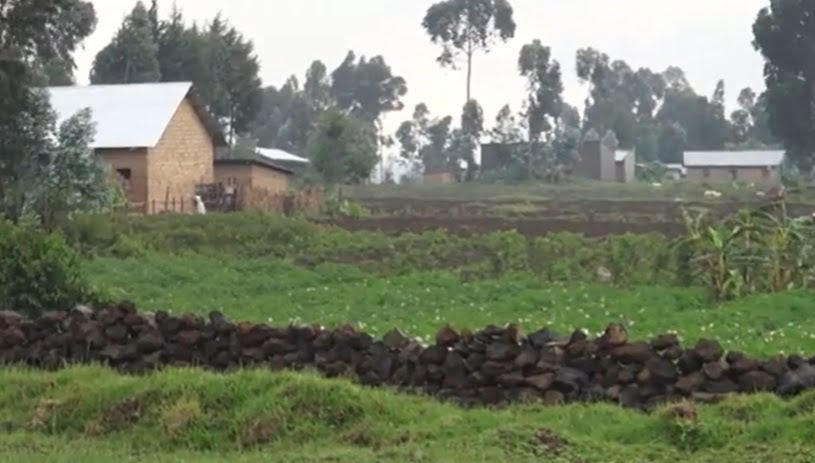
Although frequent incidents of exotic wildlife products’ smuggling have been reported in this remote rural region, the trade in animal products seems to be continuing unabated. This is mainly because local residents take advantage of the insecurity prevailing on the other side of the border with DR Congo.
Activists attribute the continued illegal trafficking of animal products to the limited efforts by local communities and grassroots leaders across trans-border regions in the fight against wildlife trafficking.
The latest figures by Rwanda Investigation Bureau (RIB) reveal that in the 2022/23 period, 24 cases related to wildlife crime were investigated, with 52 suspects involved.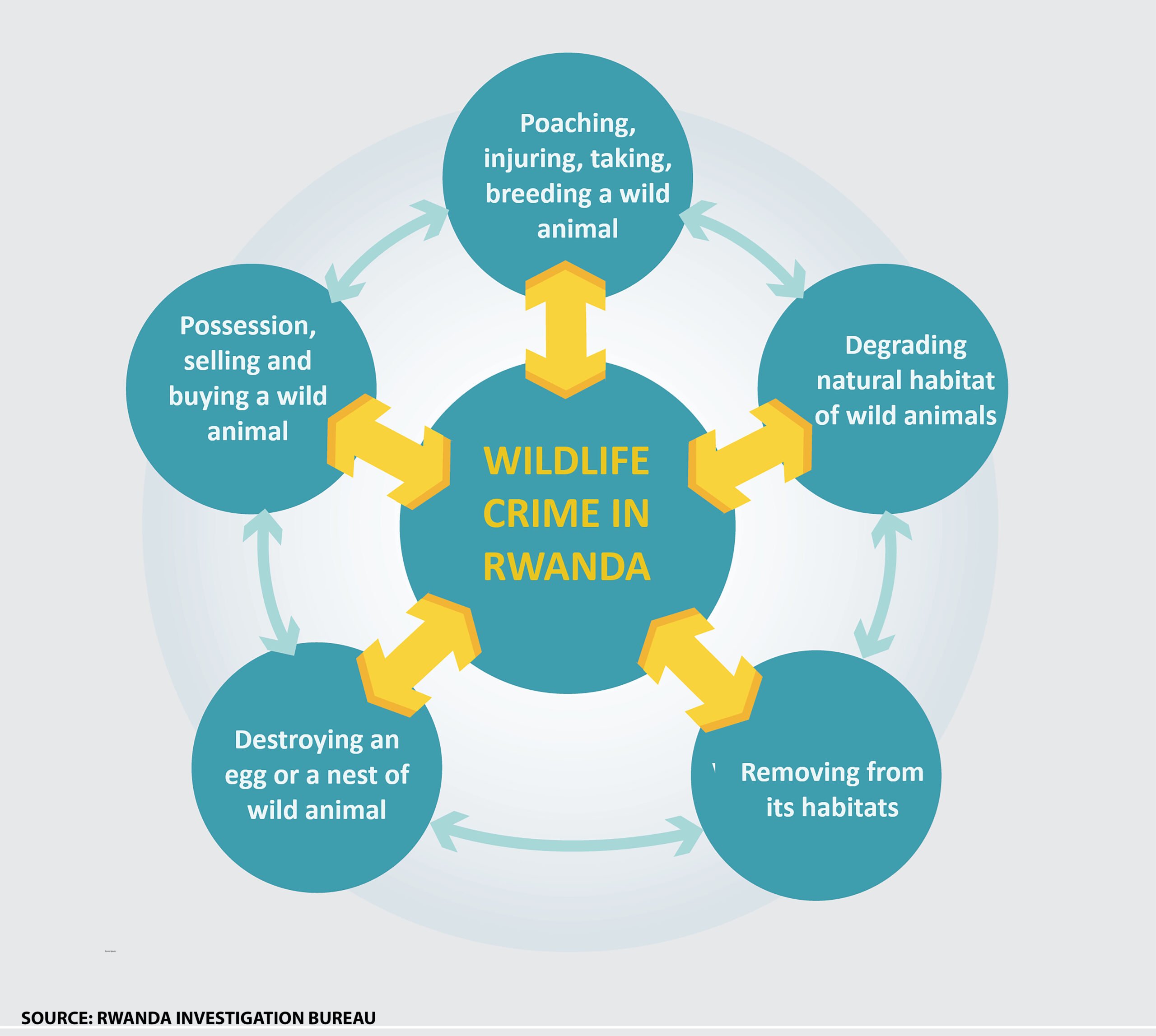
Between 2021 and 2022, at least 85 individual members of organized crime groups involved in illegal wildlife trafficking were arrested, of which 41 cases were investigated and submitted to the National Public Prosecution Authority (NPPA).
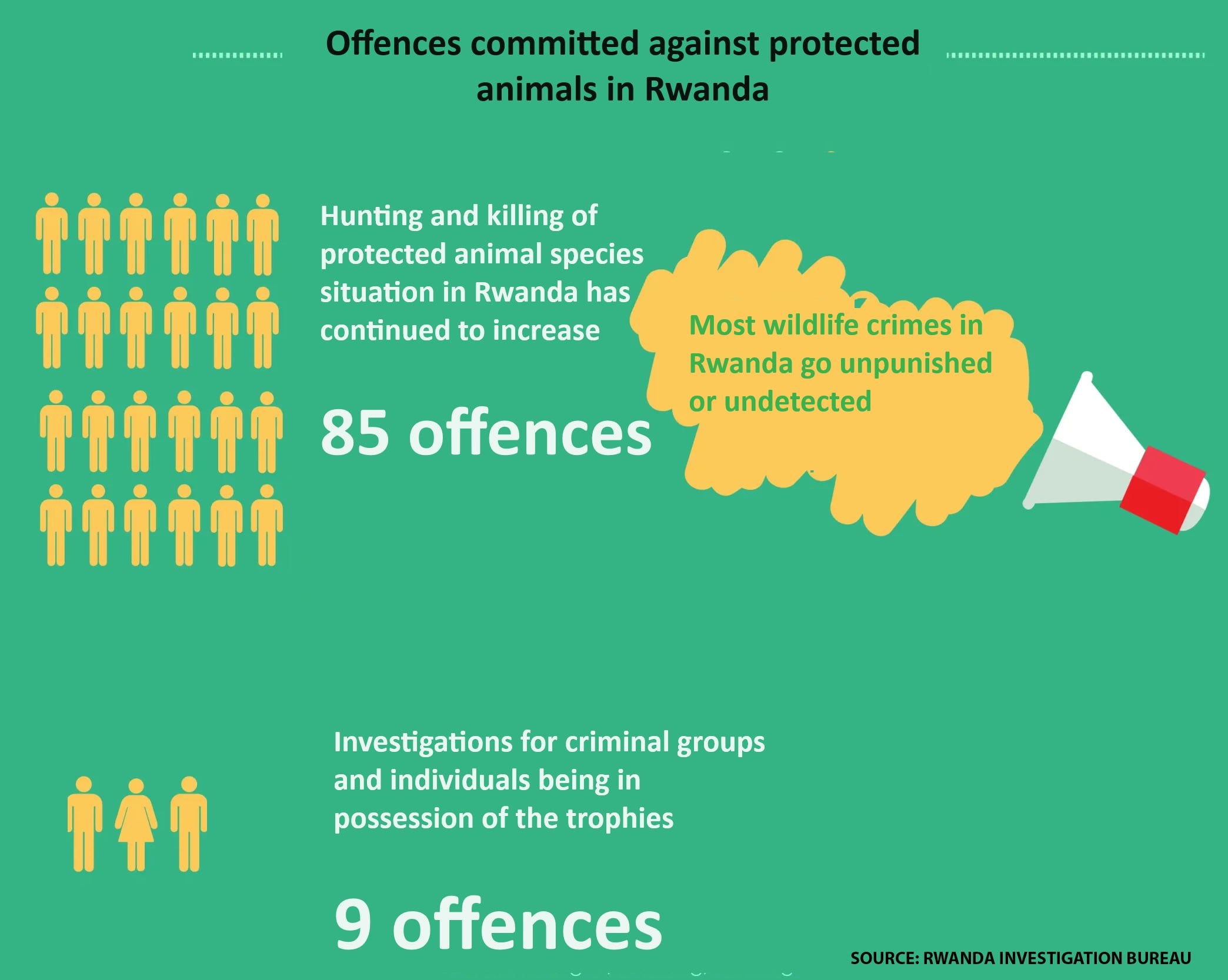
RIB reports show that the overall hunting and killing of protected animal species situation in the country has continued to increase, totaling 85 offences between 2022 and 2023, while at least 9 cases were investigated for criminal groups and individuals being in possession of the trophies.
However, estimates show that wildlife protection in Rwanda has continued to improve, with illegal wildlife crimes slightly decreasing from 63 cases investigated in 2020/21 down to 52 suspects arrested in 2022/23.

The latest report also pointed out that more and more criminals are poaching, injuring, taking, stressing and breeding wild animals or hawking animals and removing them from their habitats while manufacturing a trophy has been a common crime among cases investigated where the hunting is targeting wild animal for the purpose of acquiring their body parts, such as horns for display.
Olivier Bahemuke Ndoole, an activist and the founder of ‘’Alerte Congolaise pour l’Environnement et les Droits de l’Homme’ an NGO advocating for environmental rights, points out that the illegal wildlife trade poses a major threat to wild animals between Rwanda and DR Congo.
“The regional stabilization policy should make this aspect one of the key pillars where different enforcement agencies must establish collaboration and information sharing on the situation of wildlife trafficking,” he said in an exclusive interview.
Despite being a high-risk zone where members of armed groups and other gangs involved in transnational criminal organizations have been arrested or killed by security forces while attempting to illegally cross and escape using porous land borders, some members of the local community take advantage of loopholes in the border crossing and the high volume of informal trade to move their illicit goods undetected.
There are two key borders between Rwanda and the DRC, one at Rubavu leading to the Congolese city of Goma, the closest entry point to Virunga National Park and one at Rusizi leading to the city of Bukavu.
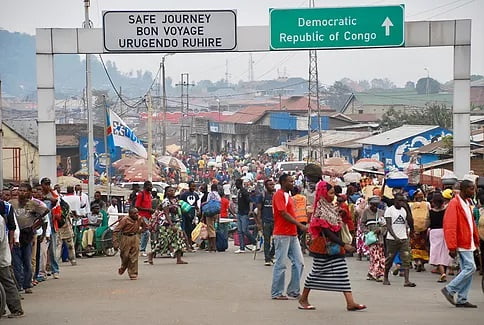
While riding the visiting reporter on his motorbike heading towards one of the legal border crossing posts, Rugaju has developed a variety of inventive ways to obscure his cargo, comprising of mainly used clothing with various wildlife products hidden inside.
“Clothing isn’t the only method of concealment, precious [animal] products such as ivory can also be hidden within food shipments because there is no strict control of movement on the side of the border,” he says.
Cross-border smuggling
In this remote rural region, the nature of the land border demarcation between two countries near Rubavu with rugged terrain and marshland, where the two countries share biodiversity-rich trans-boundary landscapes has led to the increasing wildlife trafficking involving different species such as rhino horns, elephant ivory.
Despite measures to curb cross-border smuggling of various animal species that have resulted in the arrest of several criminals over the recent years thanks to the cooperation between the Police institutions of the two countries, the situation has evolved following the latest tensions between the two countries
Even though the majority of those crossing are those engaged in informal business activities, activists note that the limited collaborative border management is another factor that exacerbated the problem of wildlife trafficking, where smugglers of wildlife products take advantage of porous borders.
“There is a confluence of causes interacting with each other to create the current problem of trafficking in wildlife especially the impunity and absence of state authority characterized by the presence of armed groups in the region,” says Ndoole, who is also an environmental lawyer and community activist from Goma, the capital city of North Kivu province
According to him, the absence of a criminal policy sensitive to biodiversity and the low involvement and collaboration of certain services between the two countries have worsened the current situation, in which a number of precious wildlife species still fall prey to trafficking.
Uncontrolled movement of people
Several national and international laws protect numerous species of fauna and flora. Despite this, criminal networks illegally traffic these animals, generating large sums of money.
Fidele Ruzigandekwe, the Deputy Executive Secretary for Programs at the Greater Virunga Transboundary Collaboration (GVTC), a collaborative framework of conservation programs along the shared borders of Rwanda, Democratic Republic of Congo and Uganda, points out that despite the current situation of insecurity in Eastern DR Congo every stakeholder is still fully committed to fighting Illegal wildlife trade.
“Because of prevailing insecurity across the border as some teams in insecure areas are not deployed, there is suspected increase in illegal activities following uncontrolled movement of people,” he said in an exclusive interview.
The latest estimates by the United Nations Office on Drugs and Crime (UNODC) show that African forest elephants, Loxodonta cyclotis, which is s native to humid tropical forests in the Congo Basin, were upgraded in 2021 to ‘Critically Endangered’ status on the IUCN Red List following an 86 per cent decline over the last three decades.

Ndoole points out that exchanges between law enforcement officials and civil society members in Rwanda and DR Congo are indispensable not only because the two sides are so interdependent but also because they need to collaborate in research and technological innovation to fight wildlife trafficking.
However, according to Ndoole, there is still a missing link. “Regional judicial cooperation in the fight against wildlife trafficking with tools adapted to the new technology is still missing,” he says.
Ruzigandekwe from GVTC adds that the role of innovative tools to keep alive the spirit of transboundary collaboration against all odds has never been more critical in the fight against wildlife trafficking between Rwanda and DR Congo.
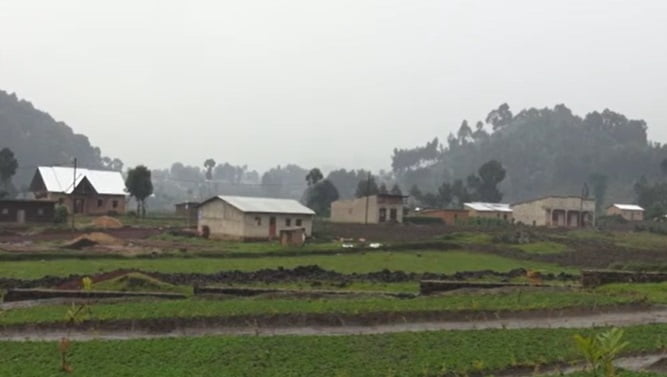
“It is important to keep an open channel for permanent dialogue for information exchange and monitoring on illegal wildlife trafficking,” he says.
Despite these commitments, both activists and conservation experts argue that operational capacity problems, are still limiting collaboration efforts on tackling the financial activity that sustains wildlife crime across the trans-border region.
Experts point out that the situation is especially aggravated by the lack of access to technology and emerging innovative tools to facilitate surveillance and control.
“High-level corruption is still a big issue among local administrative officials across the trans-border region,” said Ndoole, who attributes the current situation to the weak governance leading to unequal land distribution and poor resource management.
According to him, little effort has been made to promote joint efforts in biodiversity conservation between the two countries, yet it should be the common link and one of the justifications motivating regional cooperation.
Regional legal framework
Both activists and conservation researchers stress the importance of providing monetary and non-monetary benefits to communities living around the protected areas across the trans-border region between Rwanda and DR Congo to ensure an effective collaboration in fighting illegal wildlife trafficking.
Telesphore Ngoga, one of the wildlife experts based in Kigali, stresses the importance of filling existing gaps that may exist in the current regional legal framework to prevent and combat illicit trafficking in wildlife.
“Regional collaboration is critical to implement targeted interventions at both the demand and the supply side of the trafficking chain,” he said.
DR Congo’s Virunga National Park is home to one-third of the world’s mountain gorillas and other wildlife, which the International Union for Conservation of Nature (IUCN) classifies as endangered species.
The country shares with its neighbors Rwanda and Uganda a tropical rainforest in the volcanic region.
Most wildlife products, “experts said, are used without permits or authorization, and are imported and exported across the region without the CITES paper that regulates trade in wild species.”
However, some residents are convinced that the misuse and abuse of entrusted power by some local administrative officials on both sides of the border for private gain are also responsible for the prevailing situation in illegal wildlife trafficking.
“Common tactics include bribery of local administrative officials, and some people have accepted it as part of the way we live,” said Adele Mukamusoni, a female farmer from Busasamana, the village located a hundred metrers away on the border with DR Congo.
Yet relevant enforcement law agencies across the region have continued to collaborate in past to crack down on wildlife-related crimes; the current situation has led to a significant rise in wildlife trafficking as a result of the inefficient collaboration.
This story has been produced with the support from Internews Earth Journalism Network (EJN)

